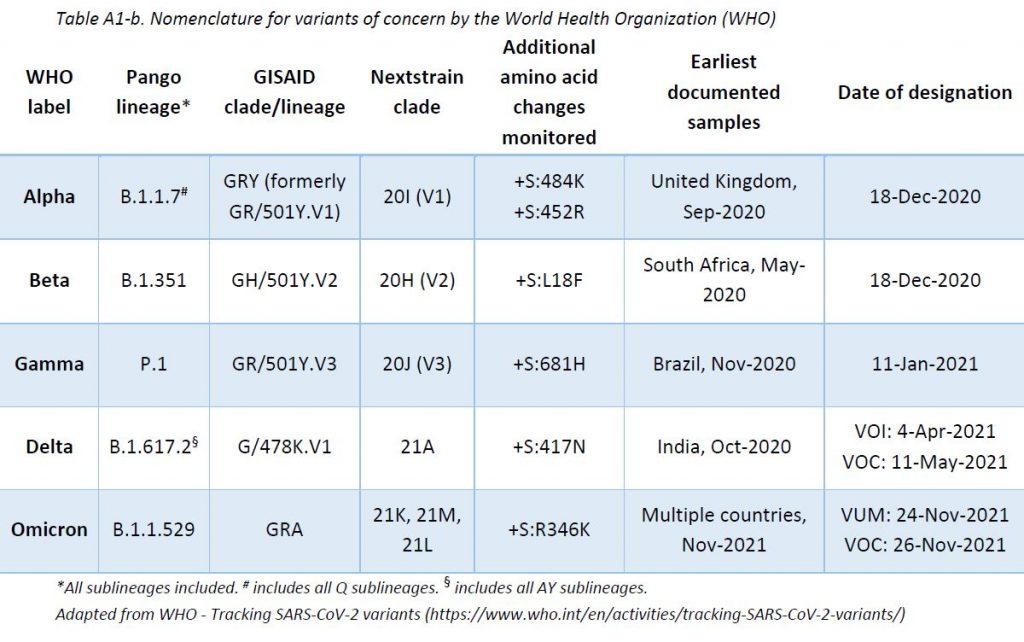
The Sentinel Surveillance Network identified 7 cases of influenza-like illness, thus remaining below the recommended threshold for the new epidemic season, according to the European Center for Disease Prevention and Control (ECDC) guidelines.
Regarding SARS-CoV-2 genomic surveillance, the LNS analysed 565 specimens from residents in Luxembourg in week 51/2021 (from 2688 total cases in the Grand Duchy of Luxembourg, 21,0%). This reaches the ECDC recommendations to detect emerging variants at 2.5% prevalence (minimum sample size of 491). Including PCR screening results, 1228 national specimens were analysed globally (45,7%).
The Omicron variant was assigned to 34,9% of national cases collected during week 51 and the Delta variant remains the dominant one. The analysis of target groups showed that Omicron is detected less frequently among hospital specimens, but more frequently than expected from previous variants among fully vaccinated individuals.

The Laboratoire national de santé, as National Reference Laboratory for Acute Respiratory Infections in Luxembourg, performs close surveillance on respiratory viruses, with a special focus on SARS-CoV-2. There are currently two active projects on which the ReViLux provides updates:
The Sentinel Surveillance Network. It provides a broad picture of respiratory diseases affecting the Luxembourgish population, based on its double monitoring system (syndromic and virological).
The National SARS-COV-2 Genomic Surveillance Program. It enables detailed observation of SARS-CoV-2 mutations and variants through time and space, and also monitoring specific groups of interest.
The Sentinel Surveillance Network aims at monitoring the circulating respiratory viruses, including SARS-CoV-2, and hence underpin public health actions. Following the World Health Organization (WHO) and European Centre for Disease Prevention and Control (ECDC) guidance, it focuses on cases of acute respiratory infection (ARI) and influenza-like illness (ILI).
Week 40 marked the beginning of the new influenza season 2021-2022. Results of syndromic surveillance during the last four weeks are displayed in Table 1 and the history of ILI consultations since the 2019-2020 season is shown in Figure 1. The number of ILI cases identified in the week of study continued to be 7 (out of 308 consultations); therefore, the percentage of ILI (2,27%) remains bellow the threshold for the epidemic season (2,59%), according to the ECDC.
Regarding the virological surveillance, a partnership among the CNS, private laboratories and the LNS recently started and will enable us to monitor the presence of several respiratory viruses. Results from the first analyses will be published soon.

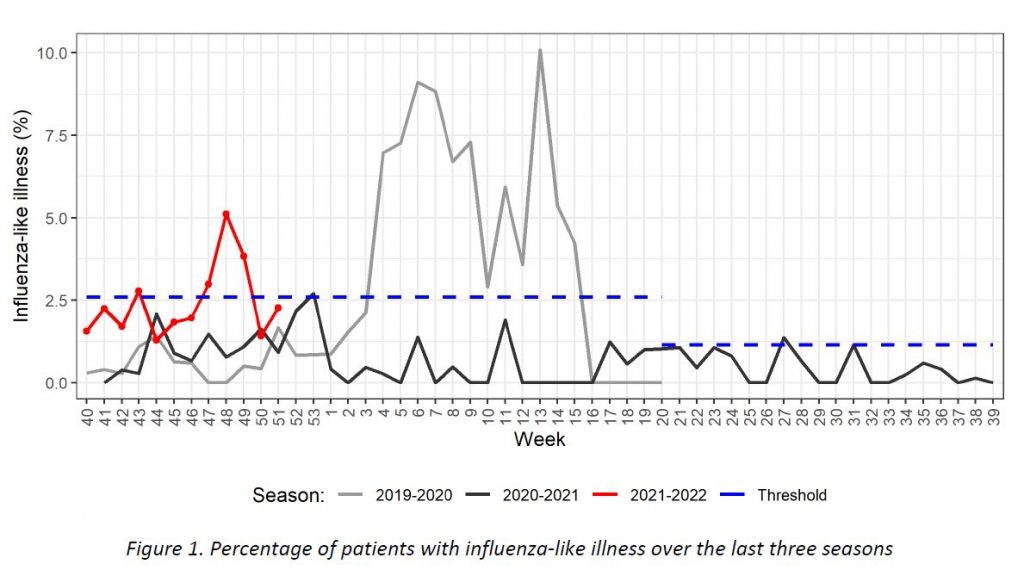
The National Reference Laboratory for Acute Respiratory Infections at LNS receives SARS-CoV-2 positive samples (nasopharyngeal or oropharyngeal swabs analysed by RT-PCR) from the national network of laboratories and proceeds as follows:
Sequencing all specimens from hospital cases.
Sequencing all specimens from post-vaccination cases.
Sequencing specimens from clusters with high transmission.
Sequencing a representative sample of community cases.
The representative sample of community cases is a systematic selection from all SARS-CoV-2 positive cases registered in Luxembourg to detect emerging variants and early increases in their incidence and transmission within the community in Luxembourg. This sample is selected according to the ECDC guidelines.
Due to the emergence of the new Omicron variant of concern, as well as the high incidence rates in the European context, the LNS is currently expanding its sequencing capacity and reactivity. Additionally, targeted PCR tests are carried systematically in order to detect potential Omicron cases within 24h from reception of the specimen. The PCR kits used target the following spike mutations: 69/70del, K417N, N501Y. The potential cases identified this way are then prioritised for confirmation by sequencing.
The LNS shares its sequencing results with GISAID EpiCov database periodically. SARS-CoV-2 lineages have been assigned based on Rambaut et al. using the Phylogenetic Assignment of Named Global Outbreak LINeages (pangolin) software (v3.1.17, pangoLEARN 2021-12-06). The Pango nomenclature is used in addition to the WHO nomenclature to enable easier visualization of links between any evolving variants and their ancestor (See nomenclature equivalences in Appendix 1). Delta lineages nomenclature is in constant review. The original Delta B.1.617.2 lineage is being re-classified into more specific AY lineages in order to enable a more precise tracing of the cases. This report is based on the latest nomenclature, and previously assigned lineages might have been updated to remain consistent with the latest nomenclature.
In week 51, 2688 new cases were registered in Luxembourg; hence, the minimum sample size required to detect emerging variants at a 2.5% incidence is estimated to be 491 specimens (18.3%).
Last week, 3106 specimens were received. Of these, 1081 specimens (including 977 national specimens), were screened by targeted PCR for the Omicron variant, in order to enable an earlier detection of potential Omicron cases (see results in the following section). In parallel, the microbial genomics unit at the LNS sequenced 640 specimens, including 565 specimens having been collected from residents; hence, the weekly sequencing coverage remains at 21,0% (565 out of 2688 cases registered in Luxembourg; see coverage trend in Figure 2). Overall, 1228 national specimens were analysed either by sequencing or screening (45,7%).
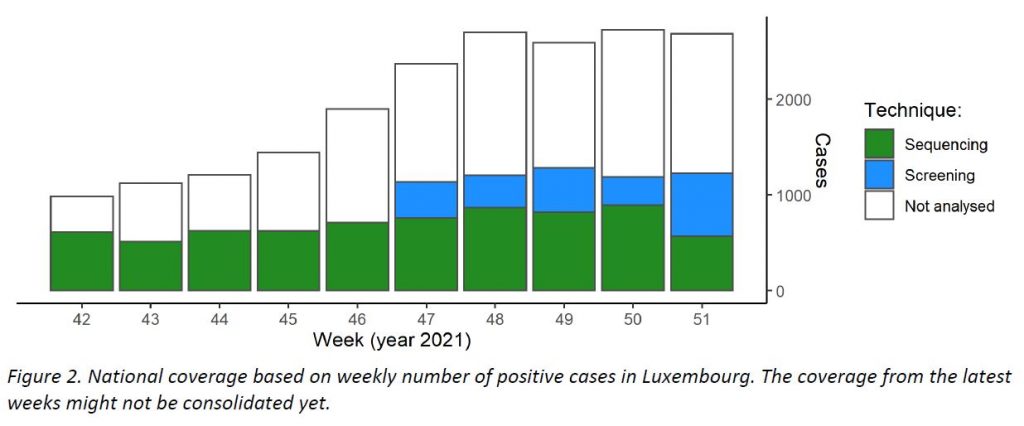
As shown in Figure 3, of the 1084 specimens from week 51 which were screened by targeted PCR, and which corresponded to either residents or non-residents, 398 were identified as potential Omicron cases (36,7%) and were prioritised for confirmatory sequencing.
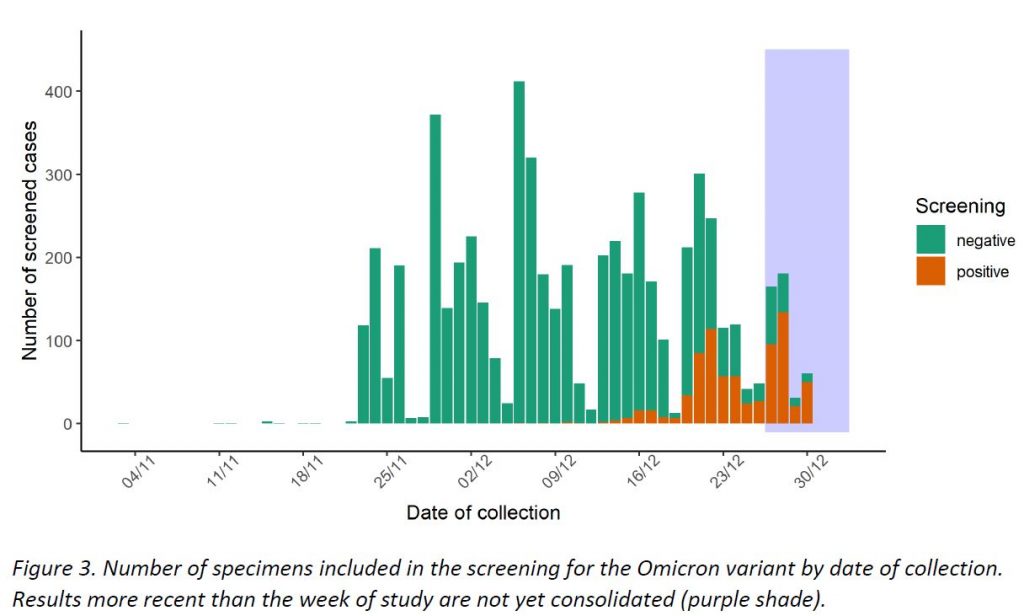
The distribution of successfully assigned lineages within the national selection sample is shown in Figure 4. Regarding Delta AY sublineages, only a selection is displayed, based on their prevalence during the last 10 weeks (min. 1%). This distribution is further detailed for the last 2 weeks in Table 2.
These results must be interpreted with caution: potential Omicron cases detected by screening are prioritised for sequencing, and this might lead to an overestimation of the actual presence of this variant.
The Delta variant continues to be the dominant one (64.9%), with the lineage AY.43 being the most frequent, but the Omicron variant has increased sharply since last week, now representing 34.9% of the national specimens. All Omicron cases were assigned to the lineage BA.1 (the most common worldwide), except for 1 unspecified and 1 BA.2. The latter is the first case of this minority lineage within the Omicron variant, which represents only 0,3% of all Omicron cases in Europe (source: GISAID).
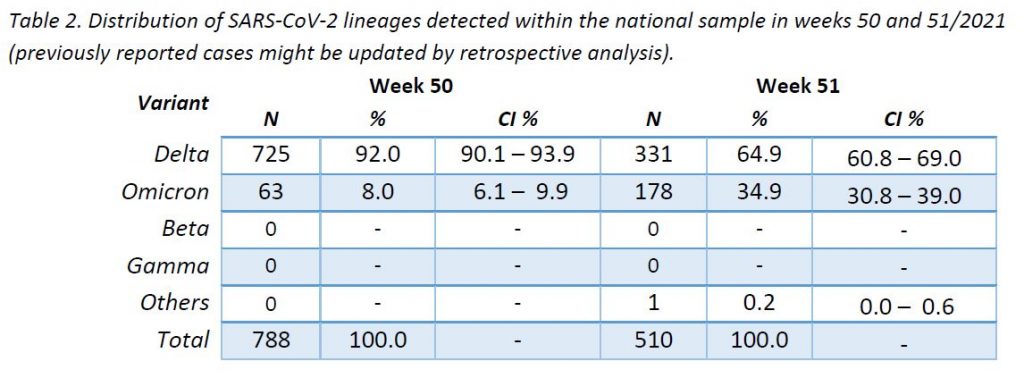
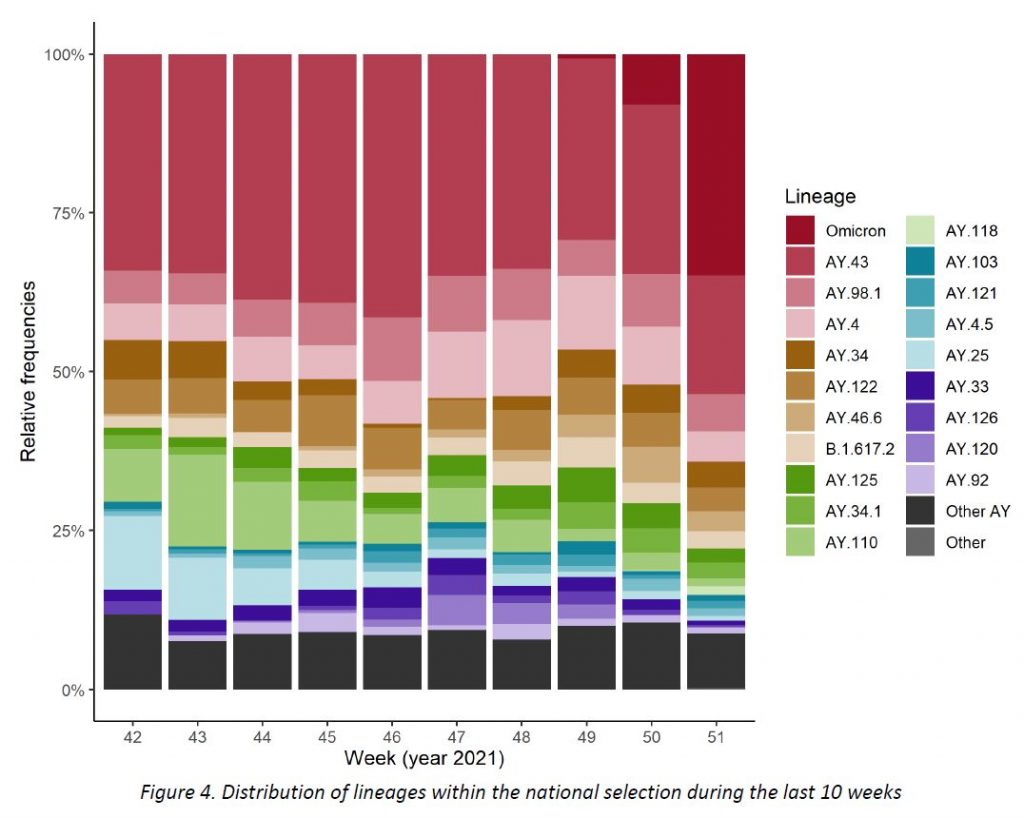
In addition to the surveillance of SARS-CoV-2 variants, the LNS monitors the occurrence of SARS-CoV-2 mutations reported to have a clinical and epidemiological relevance. This complementary surveillance enables us to detect unexpected mutations among the specimens sequenced. It is expected that VOC defining mutations share the same distribution as their corresponding VOCs. However, newly acquired mutations may occur and their early detection might be key to expect changes in the epidemic evolution.
Following ECDC guidance, the LNS is currently monitoring 42 mutations to the spike protein frequently associated to VOCs. Additionally to the 178 national specimens successfully assigned to the Omicron variant in week 51, 17 sequences with insufficient quality to be assigned to any lineage were found to carry characteristic mutations of this variant.
Centers for Disease Control and Prevention. SARS-CoV-2 Variant Classifications and Definitions. Retrieved 3 January 2022, from https://www.cdc.gov/coronavirus/2019-ncov/variants/variant-info.html
COVID-19 Data Portal – accelerating scientific research through data. (2021). Retrieved 3 January 2022, from https://www.covid19dataportal.org/sequences
European Centre for Disease Prevention and Control. Guidance for representative and targeted genomic SARS-CoV-2 monitoring – 3 May 2021. ECDC : Stockholm ; 2021
European Centre for Disease Prevention and Control. SARS-CoV-2 variants of concern. Retrieved 3 January 2022, from https://www.ecdc.europa.eu/en/covid-19/variants-concern
Genomic sequencing of SARS-CoV-2: a guide to implementation for maximum impact on public health. Geneva: World Health Organization; 2021.
GitHub – cov-lineages/pangolin: Software package for assigning SARS-CoV-2 genome sequences to global lineages. (2021). Retrieved 3 January 2022, from https://github.com/cov-lineages/pangolin
Hadfield J., Megill C., Bell S., Huddleston J., Potter B., Callender C. et al. (2018). Nextstrain: real-time tracking of pathogen evolution. Bioinformatics, 34(23), 4121-4123. doi: 10.1093/bioinformatics/bty407
Pango Network. New AY lineages. Retrieved 3 January 2022, from: https://www.pango.network/new-ay-lineages/
Pango Network. New AY lineages. Retrieved 3 January 2022, from: https://www.pango.network/new-ay-lineages-and-an-update-to-ay-4-ay-12/
Rambaut A., Holmes E., O’Toole Á., Hill V., McCrone J., Ruis C. et al. (2020). A dynamic nomenclature proposal for SARS-CoV-2 lineages to assist genomic epidemiology. Nature Microbiology, 5(11), 1403-1407. doi: 10.1038/s41564-020-0770-5
According to the ECDC
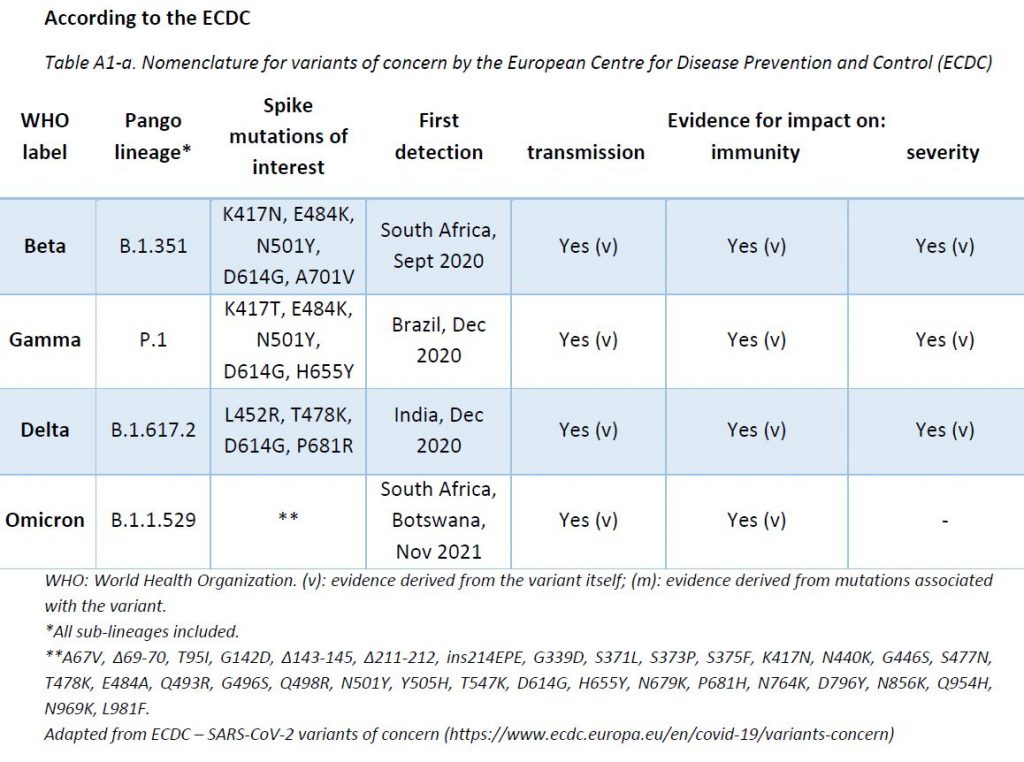
According to the WHO
